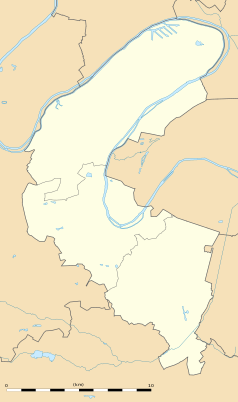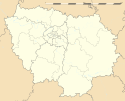Rueil-Malmaison
| miejscowość i gmina | |||
 | |||
| |||
| Państwo | |||
|---|---|---|---|
| Region | |||
| Departament | |||
| Okręg | |||
| Kod INSEE | 92063 | ||
| Mer | |||
| Powierzchnia | 14,7 km² | ||
| Populacja (2012) • liczba ludności |
| ||
| • gęstość | 5 412 os./km² | ||
| Kod pocztowy | 92500 | ||
Położenie na mapie Hauts-de-Seine (c) Eric Gaba, Wikimedia Commons user Sting, CC BY-SA 3.0 | |||
Położenie na mapie Île-de-France (c) Eric Gaba, Wikimedia Commons user Sting, CC BY-SA 3.0 | |||
| Portal | |||
Rueil-Malmaison – miejscowość i gmina we Francji, w regionie Île-de-France, w departamencie Hauts-de-Seine.
Według danych na rok 2012 gminę zamieszkiwało 79 563 osób, a gęstość zaludnienia wynosiła 5 412 osób/km². Wśród 1287 gmin regionu Île-de-France Rueil-Malmaison plasuje się na 176. miejscu pod względem powierzchni.
Zabytki i miejsca turystyczne
W Rueil-Malmaison znajduje się były zamek Józefiny de Beauarnais cesarzowej Francji, nazwany Zamkiem w Malmaison (fr. Château de Malmaison). Zameczek wraz z przylegającym do niego terenem został zakupiony i odnowiony przez Józefinę w 1799 roku i zamieszkała tam ona wraz ze swoim mężem Napoleonem Bonaparte przyszłym cesarzem Francji. Teren całej posiadłości Józefiny osiągnął 726 hektarów w momencie jej śmierci w 1814 roku. Dzisiaj w byłym Zamku w Malmaison znajduje się francuskie Muzeum Napoleońskie udostępnione do zwiedzania.
Józefina została pochowana w innym miejskim zabytku, jakim jest kościół śś. Apostołów Piotra i Pawła. Pierwotnie gotycki, w XVII wieku przyjął barokową formę. Fasada kościoła została zaprojektowana przez Jacquesa Lemerciera. W tym kościele pochowana jest również córka Józefiny, Hortensja de Beauharnais, królowa Holandii.
Miasta partnerskie
 Ávila, Hiszpania
Ávila, Hiszpania Fryburg, Szwajcaria
Fryburg, Szwajcaria Lynchburg, Stany Zjednoczone
Lynchburg, Stany Zjednoczone Elmbridge, Wielka Brytania
Elmbridge, Wielka Brytania Siergijew Posad, Rosja
Siergijew Posad, Rosja Timișoara, Rumunia
Timișoara, Rumunia Jełgawa, Łotwa
Jełgawa, Łotwa Zouk Mikael, Liban
Zouk Mikael, Liban Tōgane, Japonia
Tōgane, Japonia Bad Soden am Taunus, Niemcy
Bad Soden am Taunus, Niemcy Kitzbühel, Austria
Kitzbühel, Austria Kirjat Malachi, Izrael
Kirjat Malachi, Izrael Bardau, Tunezja
Bardau, Tunezja Dubrownik, Chorwacja
Dubrownik, Chorwacja Buchara, Uzbekistan
Buchara, Uzbekistan
Bibliografia
- Francuski urząd statystyczny. (fr.).
Media użyte na tej stronie
Autor: Superbenjamin, Licencja: CC BY-SA 4.0
Blank administrative map of France for geo-location purpose, with regions and departements distinguished. Approximate scale : 1:3,000,000
(c) Eric Gaba, Wikimedia Commons user Sting, CC BY-SA 3.0
Blank administrative map of the region of Île-de-France, France, as in January 2015, for geo-location purpose, with distinct boundaries for regions, departments and arrondissements.
Autor: Patricia.fidi, Licencja: CC0
Unofficial (de facto) flag of the region Île-de-France in France. It was also the flag of the kingdom of France (s.XIV-XV)
Autor: Pedro A. Gracia Fajardo, escudo de Manual de Imagen Institucional de la Administración General del Estado, Licencja: CC0
Flaga Hiszpanii
The flag of Navassa Island is simply the United States flag. It does not have a "local" flag or "unofficial" flag; it is an uninhabited island. The version with a profile view was based on Flags of the World and as a fictional design has no status warranting a place on any Wiki. It was made up by a random person with no connection to the island, it has never flown on the island, and it has never received any sort of recognition or validation by any authority. The person quoted on that page has no authority to bestow a flag, "unofficial" or otherwise, on the island.
Flag of Israel. Shows a Magen David (“Shield of David”) between two stripes. The Shield of David is a traditional Jewish symbol. The stripes symbolize a Jewish prayer shawl (tallit).
Łatwo można dodać ramkę naokoło tej grafiki
The flag of the United Kingdom (3:5 version). This flag is the Union Flag in the 3:5 ratio exclusively used on land. At sea, the correct ratio is 1:2.
(c) Photo: Myrabella / Wikimedia Commons, CC BY-SA 3.0
This building is classé au titre des monuments historiques de la France. It is indexed in the base Mérimée, a database of architectural heritage maintained by the French Ministry of Culture, under the references PA00088138
Autor: Moonik, Licencja: CC BY-SA 3.0
Library of the Château de Malmaison in Rueil-Malmaison, France. Situated in a wing built in 1687, the library was fitted out in 1800 by Charles Percier and Pierre-François-Léonard Fontaine for Napoleon Bonaparte.
Autor: Moonik, Licencja: CC BY-SA 3.0
Dining room of the Château de Malmaison in Rueil-Malmaison, France. Mentioned since 1703 but the new furnishing was ordered by empress Joséphine to Charles Percier and Pierre-François-Léonard Fontaine who are going to enlarge the room by adding the semicircular part, the floor covered with a luxurious black and white marble.
(c) Eric Gaba, Wikimedia Commons user Sting, CC BY-SA 3.0
Blank administrative map of the department of the Hauts-de-Seine, France, as in January 2015, for geo-location purpose, with distinct boundaries for departments and arrondissements.
Autor: Moonik, Licencja: CC BY-SA 3.0
The apartment of empress Joséphine in the Château de Malmaison in Rueil-Malmaison, France. Installed in 1800 in the north part of the Château, this apartment which the consular couple shared during several years stayed in the Joséphine's exclusive usage after 1803. The room of the Empress, luxuriously decorated in 1812 in the shape of a tent with sixteen pieces, exhibits the original bed.
Autor: Moonik, Licencja: CC BY-SA 3.0
Billiard room in the Câteau de Malmaison in Rueil-Malmaison, France. Situated at the ground floor of the Château, this room was allocated to the billiard game since 1703. The current decoration is designed by Louis-Martin Berthault in 1812, with the sober furniture as at the time of Joséphine de Beauharnais.
Autor: Virginie Pringuet, Licencja: CC BY-SA 4.0
This building is indexed in the base Mérimée, a database of architectural heritage maintained by the French Ministry of Culture, under the references IA00064604




































